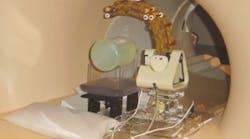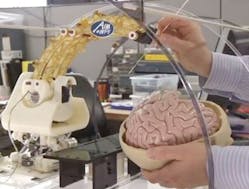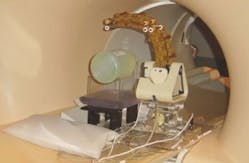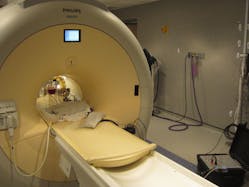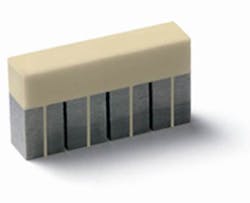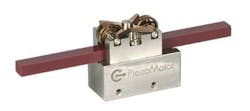A completely nonmetallic surgical robot, able to work on patients lying in MRI machines, is under development at Worcester Polytechnic Institute, Worcester, Mass. The robot can position a high-energy, ultrasound probe exactly at a tumor site.
The linear piezomotors are complete self-contained units that include a drive rod. They use multiple sets of bimorphic drive legs, each leg consisting of two piezoelectric layers cemented together so an applied voltage makes one layer contract, the other expand. Applying a voltage makes the legs flex slightly.
Alternating pairs of legs "walk" a drive rod forward in nanometer steps at speeds as high as 15 mm/sec. One set of legs always touches the actuator, making the actuators inherently safe (providing braking when unpowered) with the motors provide a holding force of up to 10 N.The WPI robot consists of one module with X, Y, Z translation and two rotational modules that correspond to the arc angles of a head frame. Linear motors handle a needle insertion and rotary motors drive aluminum leadscrews via 3D-printed custom pulleys and rubber or fiberglass-reinforced timing belts.
Although the masses involved are small, the materials generte more friction than conventional designs, so they need high torque to produce motion.
FPGA signals go to high-speed d/a converters and then to high-bandwidth, high-voltage linear amplifiers. External filters remove electrical noise. An encoder provides feedback for closed-loop position or velocity control.
Up to eight of these boards, one per axis, sit in a modular backplane inside a shielded enclosure inside the MRI scanner room with the robot. A custom cable harness connects the controller and robot.
To demonstrate the approach, the team is creating variations of the MRI robot for uses in treating brain cancer and Parkinson’s disease, and for performing biopsies of prostate cancers.
